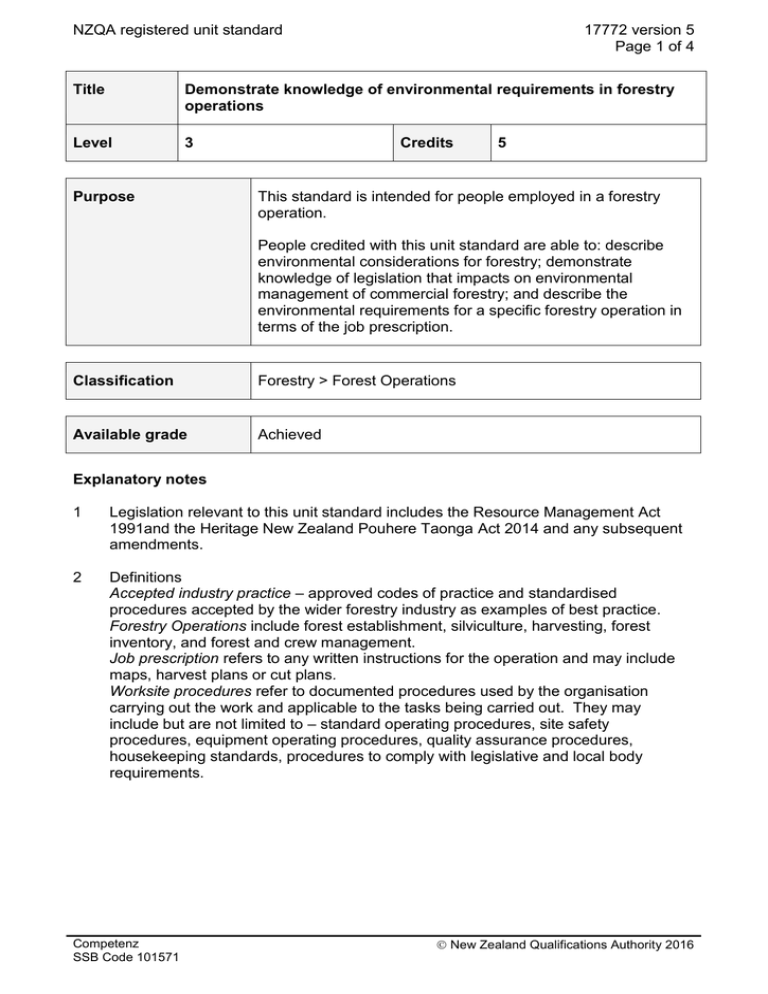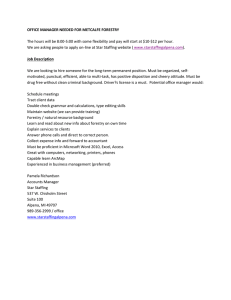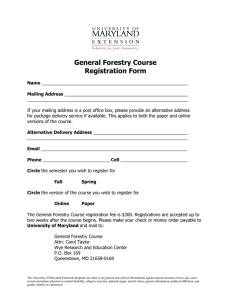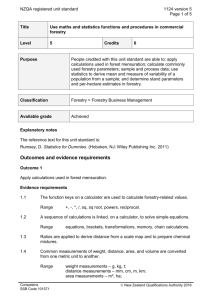NZQA registered unit standard 17772 version 5 Page 1 of 4
advertisement

NZQA registered unit standard 17772 version 5 Page 1 of 4 Title Demonstrate knowledge of environmental requirements in forestry operations Level 3 Purpose Credits 5 This standard is intended for people employed in a forestry operation. People credited with this unit standard are able to: describe environmental considerations for forestry; demonstrate knowledge of legislation that impacts on environmental management of commercial forestry; and describe the environmental requirements for a specific forestry operation in terms of the job prescription. Classification Forestry > Forest Operations Available grade Achieved Explanatory notes 1 Legislation relevant to this unit standard includes the Resource Management Act 1991and the Heritage New Zealand Pouhere Taonga Act 2014 and any subsequent amendments. 2 Definitions Accepted industry practice – approved codes of practice and standardised procedures accepted by the wider forestry industry as examples of best practice. Forestry Operations include forest establishment, silviculture, harvesting, forest inventory, and forest and crew management. Job prescription refers to any written instructions for the operation and may include maps, harvest plans or cut plans. Worksite procedures refer to documented procedures used by the organisation carrying out the work and applicable to the tasks being carried out. They may include but are not limited to – standard operating procedures, site safety procedures, equipment operating procedures, quality assurance procedures, housekeeping standards, procedures to comply with legislative and local body requirements. Competenz SSB Code 101571 New Zealand Qualifications Authority 2016 NZQA registered unit standard 17772 version 5 Page 2 of 4 Outcomes and evidence requirements Outcome 1 Describe environmental considerations for forestry. Evidence requirements 1.1 Natural and physical resources associated with commercial forestry are identified. 1.2 The positive environmental effects of plantation forestry are described. Range 1.3 clean water and air, wildlife habitat, land stability, recreation, flood mitigation, employment. The potential adverse environmental effects of plantation forestry operations are described. Range erosion, soil displacement, reduced water quality, reduced air quality, negative impacts on aquatic life, compaction, damage to historic sites, damage to neighbouring properties, damage to physical resources, public impressions. Outcome 2 Demonstrate knowledge of legislation that impacts on environmental management of commercial forestry. Evidence requirements 2.1 The main purpose of the Resource Management Act is described. 2.2 The main responsibility of individual forestry employees is described in accordance with the Resource Management Act. 2.3 The main impact of the Resource Management Act on forestry operations is identified. 2.4 The main purpose of the Heritage New Zealand Pouhere Taonga Act 2014 is described. 2.5 The main responsibilities of individual forestry employees upon discovery of an historic site are described in accordance with the Heritage New Zealand Pouhere Taonga Act 2014. 2.6 Commercial forestry activities that are controlled by regional or district councils are identified. Range 2.7 evidence of three activities is required. The liabilities and penalties under environmental legislation are described. Competenz SSB Code 101571 New Zealand Qualifications Authority 2016 NZQA registered unit standard Range 17772 version 5 Page 3 of 4 fines and imprisonment, people involved. Outcome 3 Describe the environmental requirements for a specific forestry operation in terms of the job prescription. Range one of the following operations – land preparation, forest harvesting, forest silviculture, forest roading. Evidence requirements 3.1 The job prescription for the forest operation is described in terms of the environmental constraints on the operation. 3.2 The environmental values that may be at risk from the forestry operation are identified. 3.3 The person who has overall responsibility for ensuring compliance with environmental legislation, and internal company standards or systems at a worksite is identified. 3.4 The terms environmental incident and/or environmental emergency are explained in accordance with accepted industry practice or company environmental management system. 3.5 Reporting of an environmental incident or emergency is described in accordance with accepted industry practice or worksite procedures. Planned review date 31 December 2020 Status information and last date for assessment for superseded versions Process Version Date Last Date for Assessment Registration 1 5 December 2000 31 December 2012 Review 2 22 May 2008 31 December 2012 Revision 3 16 July 2010 31 December 2016 Review 4 19 March 2015 31 December 2017 Review 5 10 December 2015 N/A Consent and Moderation Requirements (CMR) reference 0173 This CMR can be accessed at http://www.nzqa.govt.nz/framework/search/index.do. Competenz SSB Code 101571 New Zealand Qualifications Authority 2016 NZQA registered unit standard 17772 version 5 Page 4 of 4 Please note Providers must be granted consent to assess against standards (accredited) by NZQA, before they can report credits from assessment against unit standards or deliver courses of study leading to that assessment. Industry Training Organisations must be granted consent to assess against standards by NZQA before they can register credits from assessment against unit standards. Providers and Industry Training Organisations, which have been granted consent and which are assessing against unit standards must engage with the moderation system that applies to those standards. Requirements for consent to assess and an outline of the moderation system that applies to this standard are outlined in the Consent and Moderation Requirements (CMR). The CMR also includes useful information about special requirements for organisations wishing to develop education and training programmes, such as minimum qualifications for tutors and assessors, and special resource requirements. Comments on this unit standard Please contact Competenz at qualifications@competenz.org.nz if you wish to suggest changes to the content of this unit standard. Competenz SSB Code 101571 New Zealand Qualifications Authority 2016


